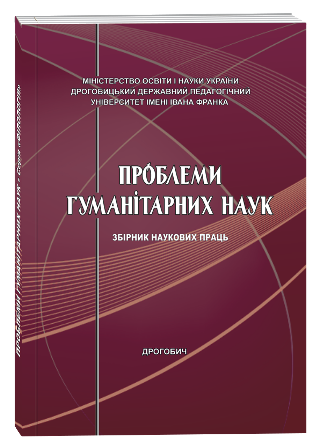THE SEMANTICS OF PLURALIS MODESTIAE IN THE WRITTEN PROTOCOL OF THE SEE OF CONSTANTINOPLE ON THE EXAMPLE OF THE EPISTLES OF PATRIARCH BARTHOLOMEW
DOI:
https://doi.org/10.24919/2522-4565.2022.49.17Keywords:
Katharevousa, written protocol, the See of Constantinople, Epistle, Patriarch Bartholomew, first person plural (1 Plur), pluralis modestiae, pluralis sociativus, pluralis majestatis.Abstract
The article examines the specifics of the use of the grammatical form of the pronoun and the verb of the first person plural (1 Plur) in the meaning of the first person singular (1 Sing) in the written protocol of the See of Constantinople on the example of Epistles of Patriarch Bartholomew. It is noted that the pronoun and verb of the 1 Plur in the meaning of the first person singular (1 Sing) is a feature of the official written protocol of the See of Constantinople; the formation of this grammatical figure has been traced through the analysis of usages recorded in literary and religious texts since ancient times. The analysis of the Patriarch’s Epistles has shown that Patriarch Bartholomew uses the grammatical form of 1 Plur in three cases: first, in the sense of “pluralis sociativus”, classifying himself as an Orthodox Christian. The second case of the use of “pluralis modestiae” – in the sense of “pluralis majestatis” – is the embodiment of the highest state power in one person who performs higher state functions and therefore loses his identity. The use of “pluralis majestatis” emphasizes the official functions of the Patriarch as a legal entity, which heads and manages the ancient See of Constantinople, that has the right of honor over all local Orthodox churches. This status automatically confirms the personal modesty of the Primate of the Church, because it prohibits the Patriarch from public conduct and expression as a private person. The main attention is focused on the context of the third case of use of “pluralis modestiae” in the Patriarch’s Epistles, which is “pluralis modestiae” in its literal sense. The semantics of this context focuses on the liturgical and moral aspects of Christian theology. The marker of the literal meaning of the lexeme “modesty” is the nominal lexeme Μετριότης and its variant ἡμετέρα Μετριότης, used by bishops or patriarchs instead of “I” as a manifestation of modesty, as a sign of humility. The semantics of this lexeme has been analyzed on the basis of Greek dictionaries.
References
Лабецька Ю. Б. Грецьке мовне питання : сучасний стан досліджень. Вчені записки Таврійського національного університету ім. Вернадського. Серія: Філологія. Журналістика. 2020. № 3. Том 2. С. 7–12.
Черноглазов Д. А. Замечания о византийском эпистолярном этикете XII в. : pluralis modestiae и pluralis reverentiae. 2015. URL: https://journals.urfu.ru/index.php/Izvestia2/article/view/1841/1701 (дата звернення 10.01.2022).
Conti L. A first approach to ἡμεῖς in place of ἐγώ in Sophocles and Euripides : a deactualising device and expression of self-dignity. Graeco-Latina Brunensia. 2021. Vol. 26. Iss. 1. P. 23–35. DOI: 10.5817/ GLB2021-1-2.
Liddel H., Scott R. Μέγα λεξικόν της Ελληνικής γλώσσης μεταφρασθέν εκ της αγγλικής εις την ελληνική υπό Ξ. Μόσχου, Αθήναι: εκδ. Οίκος Ι. Σιδερής. Τ. 3. 2001.
Yatsushiro K., Sauerland U., Alexiadou A. The Unmarkedness of Plural : Crosslinguistic Data. Proceedings of the 41st annual Boston University Conference on Language Development, edited by Maria LaMendola and Jennifer Scott Cascadilla Press Somerville, MA 2017. P. 753–765.
Sauerland U., Anderssen J., Yatsushiro K. The Plural Is Semantically Unmarked. Linguistic Evidence : Empirical, Theoretical, and Computational Perspectives. 2005. P. 413–434.
Γιανναράς Χ. Με ακρωτηριασμένες ρίζες, ποια επιβίωση; 31.03.2013. URL: https://www.kathimerini.gr/ opinion/734500/me-akrotiriasmenes-rizes-poia-epiviosi-2/ (дата звернення 10.01.2022).
Η Πατριαρχική Απόδειξη για την εορτή των Χριστουγέννων 2021. URL: https://12nisospress.com/ i-patriarxiki-apodeiksi-gia-tin-eorti-ton-xristougennon-2021/ (дата звернення 10.01.2022).
Κοραής Α. ’Ατακτα, τόμος πέμπτος, μέρος πρώτον, αλφάβητο τρίτον, εν Παρισίοις, εκ της Τυπογραφίας Κ. Εβεράρτου. 1835. 609 σ. Κριαράς Ε. Λεξικό της μεσαιωνικής ελληνικής δημώδους γραμματείας. Θεσσαλονίκη, 1988.
Τόμος Ι’.383 σ. Λεξικό της κοινής νεοελληνικής. Ινστιτούτο Νεοελληνικών Σπουδών (Ίδρυμα Μανόλη Τριανταφυλλίδη, 2002. 1532 σ. Μπαμπινιώτης Γ. Λεξικό της Νέας Ελληνικής Γλώσσας. Κέντρο Λεξικολογίας. 2002. 2032 σ.
Ὅμηρος. Ἰλιάς. URL: http://www.magister.msk.ru/library/babilon/greek/homer/grhomer.htm (дата звернення 10.01.2022). Πατριαρχική Ἀπόδειξις ἐπί τῷ Ἁγίῳ Πάσχα 2008. URL: http://ec-patr.eu/docdisplay.php?lang= gr&id=897&tla=gr (дата звернення 10.01.2022). Πατριαρχική Ἀπόδειξις ἐπί τῷ Ἁγίῳ Πάσχα 2014. URL: https://www.saint.gr/19/texts.aspx п 2014 (дата звернення 10.01.2022). Πατριαρχική Ἀπόδειξις ἐπί τῷ Ἁγίῳ Πάσχα 2015. URL: http://ec-patr.eu/docdisplay.php?lang=gr&id= 2108&tla=gr (дата звернення 10.01.2022).
Πατριαρχική Ἀπόδειξις ἐπί τῷ Ἁγίῳ Πάσχα 2016. URL: https://www.saint.gr/116/texts.aspx (дата звернення 10.01.2022).
Πλούταρχος. Ἀλέξανδρος. URL: https://www.greeklanguage.gr/digitalResources/ancient_greek/library/ browse.html?text_id=103&page=18 (дата звернення 10.01.2022).
Πλούταρχος. Βίοι Παράλληλοι / Δημοσθένης. URL: https://tiresias.haifa.ac.il/?subj=damis (дата звернення 10.01.2022).
Χαλέβας Κ. Η Ορθόδοξη Εκκλησία και η διαχρονική πορεία της γλώσσας μας. 26/11/2018. URL: https:// charatheou.gr/?p=1163 (дата звернення 19.01.2022).



